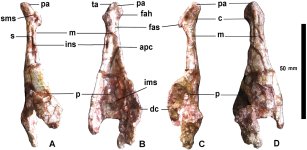Fred Ruhe
Well-known member

Eric Buffetaut, Delphine Andst & Haiyan Tong, 2023
A new enantiornithine bird from Upper Cretaceous non-marine deposits at Villespassans (Hérault, southern France)
Annales de Paléontologie Volume 109, Issue 1, January–March 2023, 102585
doi:10.1016/j.annpal.2022.102585
Abstract: A new enantiornithine bird from Upper Cretaceous non-marine deposits at Villespassans (Hérault, southern France)
A coracoid of an enantiornithine bird from Upper Cretaceous (probably late Campanian) fluvial sediments at Castigno (Villespassans, Hérault, southern France) is described. It differs from all hitherto reported enantiornithine coracoids and is referred a new genus and species, Castignovolucris sebei. This bone is large and robust, indicating a bird that was among the largest known enantiornithines, possibly the size of a Canada Goose (Branta canadensis). The new taxon is an addition to the short list of Late Cretaceous birds from France and confirms that enantiornithines were an important component of European avifaunas until late in the Cretaceous.
Enjoy,
Fred
A new enantiornithine bird from Upper Cretaceous non-marine deposits at Villespassans (Hérault, southern France)
Annales de Paléontologie Volume 109, Issue 1, January–March 2023, 102585
doi:10.1016/j.annpal.2022.102585
Abstract: A new enantiornithine bird from Upper Cretaceous non-marine deposits at Villespassans (Hérault, southern France)
A coracoid of an enantiornithine bird from Upper Cretaceous (probably late Campanian) fluvial sediments at Castigno (Villespassans, Hérault, southern France) is described. It differs from all hitherto reported enantiornithine coracoids and is referred a new genus and species, Castignovolucris sebei. This bone is large and robust, indicating a bird that was among the largest known enantiornithines, possibly the size of a Canada Goose (Branta canadensis). The new taxon is an addition to the short list of Late Cretaceous birds from France and confirms that enantiornithines were an important component of European avifaunas until late in the Cretaceous.
Enjoy,
Fred
Last edited:




